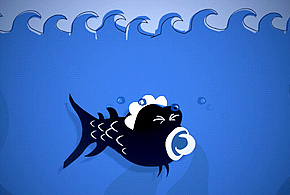
Fishtale
This week in DC, concern over a scientific study that found “intersex fish” in the Potomac resonated only briefly around my office and circle of friends. I have tried impress my concern upon them that we are, in fact, drinking Potomac River water here in DC (and in some of the surrounding suburbs like Arlington). The question of course is: if this is happening to the fish, what could it mean for us? These intersex fish are male bass, both large and small mouthed, who are developing eggs in their reproductive tissues. They were first discovered in 2003, but the news is that their numbers have increased.
This hermaphroditic phenomenon is thought to happen because of endocrine disruptors, pollutants or chemicals that promote estrogen production, present in the water. The EPA, though conducting ongoing studies on endocrine disruptors, has yet to issue any guidelines to water treatment plants about allowable levels of estrogen in drinking or evacuated waters. This discovery is not limited to the DC area. Elevated levels of endocrine disruptors and estrogen have been detected in U.S. waterways throughout the country by the U.S. Geological Survey (you can read the report through this link). This estrogen appearance can be linked with birth control pills, pharmecuetical company waste water, sewage, or a combination of several pollutants causing unpredictable effects upon our environment and the beings residing in it.
“Experts” have made public announcements that there is no evidence to indicate our drinking water is unsafe. They attribute this to the fact that fish are at a higher risk for these mutations due to their body size and because they are constantly in the water. I am drinking bottled water.





